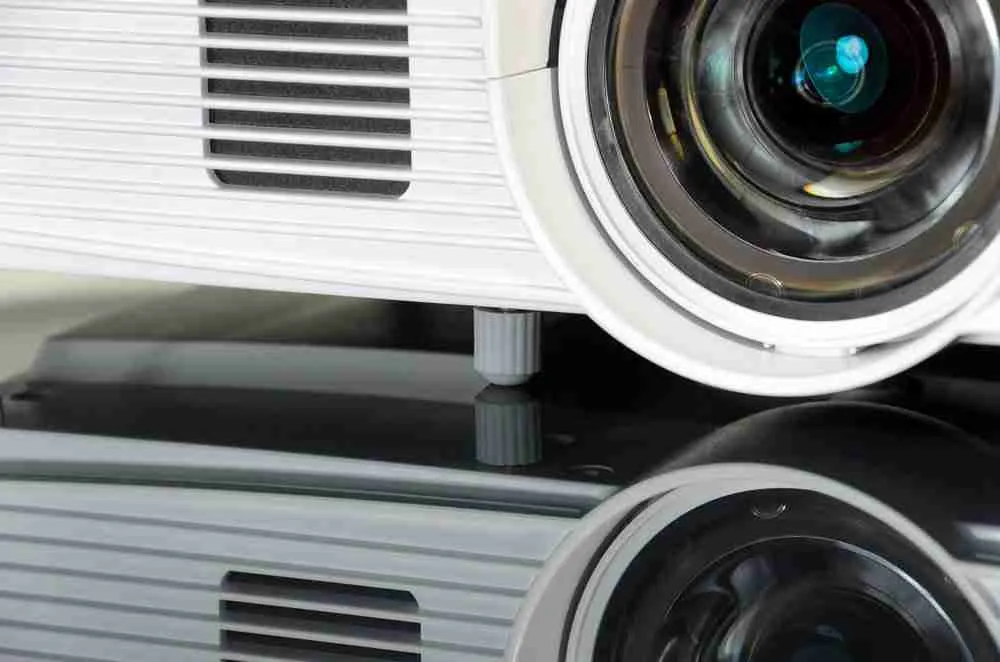LED, LCD, and DLP projector are the three main projector technology options available. A portable DLP projector is, without a doubt, one of the most advanced projectors available today out of the three.
DLP or Digital Light Processing works by converting picture signals into optical signals via digital processing and projecting the visible light onto a screen using the device’s projection lens.
DLP projectors are the most sophisticated projectors you can get currently. One of the benefits of DLP projectors is that the projected image is clearer than with an LED projector or liquid crystal display/LCD projector.
The visuals are brighter and more lifelike thanks to DLP technology’s processing. 3D movies are getting popular, and most people prefer to watch them or play video games on a DLP smart projector.
If you have a large screen and a dark entertainment area in your home theater, the visual effects are as excellent as going to the movies.
If you’re reading this article, you are likely interested in purchasing a DLP projector. Here, we cover what to look for in a DLP projector to get the best projected image quality for your entertainment or business needs.
What to Look for in a DLP Projector
DLP projectors are available in a wide range of features, projector accessories, and price ranges. Various combinations are appropriate for multiple uses.
From a home cinema to portable presentations at conference centers, these devices have a variety of applications. We’ll cover each point and explain what you need to know to choose the best projector for your needs.
1. Resolution
The first thing to look for is the resolution. Each mirror creates one pixel, and screen resolution correlates to the total number of tiny mirrors.
A 2K DLP projector, for example, contains around 2.2 million tiny mirrors.
A 4K gadget is approximately 8.8 million. The better the visual quality, the higher the resolution. Demand for a 4K DLP projection is expected to skyrocket.
It has a powerful DLP 4K Ultra HD chip and XPR technology ideal for home theater. Some 4K projectors may claim to support 4K when compared, but this isn’t the same thing as recreating 4K photos.
DLP projectors must output at least 8 million active pixels to qualify as real UHD projections, defined by the Consumer Technology Association (CTA).
Take note of this when purchasing your DLP projector.
2. DLP Projector Brightness
Lumens, or the amount of light emitted by a projector, quantify its brightness. The brighter the projector, the more lumens it has. It’s also worth noting that brighter isn’t necessarily better.
To get the best result, outdoor environments like your backyard do not necessarily require the brightest laser projector. Consider that the more brightness the projector emits, the higher the price.
Brightness requirements are influenced by several factors, including ambient lighting and the size of your entertainment area or conference room.
Ambient lighting
Higher brightness is required to produce a sharper image in viewing spaces with a lot of illumination. Lower brightness (but greater contrast ratios) produces excellent results in gloomy environments, such as a home theatre. Mid-range brightness, ranging from 2,000 to 4,000 lumens, is ideal for multi-purpose rooms.
Room/Screen size
Larger spaces and screens need brighter visuals. The brighter a projector is, the better it disperses light across an area. The number of individuals you expect to have in a room is a good indicator of how big the screen should be. In general, more people in the room means a greater screen size.
3. Contrast Ratio
The contrast ratio matches a projector’s darkest and brightest output. The better the visual quality, the higher the contrast ratio. The contrast ratios of DLP projectors range from 500:1 to 100,000:1.
For home theatre projectors and high-end applications, contrast ratio is critical. Look for a contrast ratio of 10,000:1 to 100,000:1 for your home cinemas.
The bigger, the better. Choose the ideal option for big venues, such as auditoriums which are 100,000:1.
A high contrast ratio in schools and conference rooms is less important because the advantages are most visible in highly light-controlled, pitch-black environments. Look for contrast ratios of 4,000:1 to 30,000:1 for business and classrooms.
Types of DLP projectors based on the light source
DLP projectors are classified by the light source and image technologies they use. DLP projectors currently employ lasers or LEDs, which are more efficient, environmentally friendly, and last longer. A rotating color wheel is no longer required with these latest technologies.
Traditional Lamp-based DLP projector
Most DLP projectors use traditional lights. The most significant benefit of lights is their low cost, far less than any other alternative. Lamps generally last 3,000-4,000 hours under normal conditions before needing to be replaced.
DLP projectors with lamp technology offer exceptional value while producing large and bold pictures. They’re popular for gaming and home theatre. If you plan to use your projector for gaming, look for DLP projectors with reduced input latency.
LED DLP projectors
LEDs (light-emitting diodes) create light in this type of DLP projector. LEDs resemble tiny light bulbs, but they are driven by an electrical circuit and lighted by an electron flow. LEDs live significantly longer than typical projector bulbs since they don’t have a filament. They stay cooler, don’t require a fan, and use a lot less energy.
An LED projector turns on instantly, allowing you to watch without having to wait. LED technology is also devoid of mercury.
Laser DLP Projectors
For large-screen and large entertainment spaces, laser projectors are jam-packed with functionality. 5,000 lumens burn brilliantly through ambient light in huge conference halls and auditoriums.
Several high-end features make installation and maintenance a breeze. For a low total cost of ownership, laser DLP projectors should provide 20,000 to 30,000 hours of maintenance-free use (TCO).
This is the DLP projector I use and recommend




